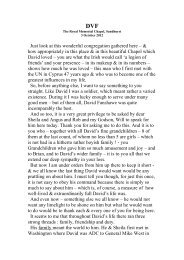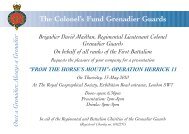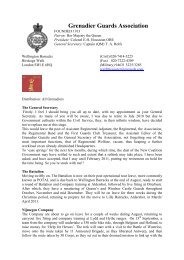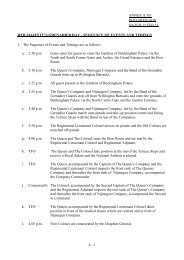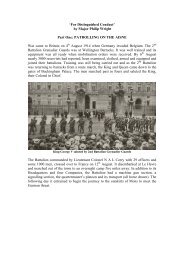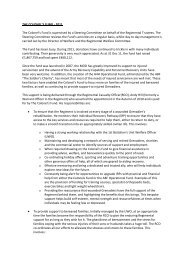The History of the Mareth Cross Grenadier ... - Grenadier Guards
The History of the Mareth Cross Grenadier ... - Grenadier Guards
The History of the Mareth Cross Grenadier ... - Grenadier Guards
You also want an ePaper? Increase the reach of your titles
YUMPU automatically turns print PDFs into web optimized ePapers that Google loves.
<strong>The</strong> <strong>History</strong> <strong>of</strong> <strong>the</strong> <strong>Mareth</strong> <strong>Cross</strong><strong>Grenadier</strong> Gazette, 2009In a recess in <strong>the</strong> boundary wall <strong>of</strong> <strong>the</strong> <strong>Guards</strong> Chapel forecourt, facing <strong>the</strong> Chapel, stands <strong>the</strong><strong>Mareth</strong> <strong>Cross</strong> - a memorial dedicated to <strong>the</strong> memory <strong>of</strong> all Ranks <strong>of</strong> <strong>the</strong> 6 th Bn <strong>Grenadier</strong><strong>Guards</strong> killed in <strong>the</strong> fateful attack on <strong>the</strong> <strong>Mareth</strong> Line in Tunisia on <strong>the</strong> night 16/17 March1943. This account is not <strong>the</strong> story <strong>of</strong> that battle, which is well documented in “<strong>The</strong> <strong>Grenadier</strong><strong>Guards</strong> in <strong>the</strong> war <strong>of</strong> 1939 - 1945” and in various o<strong>the</strong>r publications. It is purely an account <strong>of</strong>how this symbol came into being and its movements culminating in its being installed in itsfinal resting place.By <strong>the</strong> end <strong>of</strong> March 1943 <strong>the</strong> much depleted Battalion had moved on, playing its partin keeping up pressure on <strong>the</strong> retreating Afrika Korps. On 29 March, a party led by, <strong>the</strong> <strong>the</strong>n,Drill Sgt George Hackett, and comprised mainly <strong>of</strong> members <strong>of</strong> <strong>the</strong> Pioneer Platoon, returnedto <strong>the</strong> battle area with <strong>the</strong> task <strong>of</strong> burying <strong>the</strong> dead, including <strong>the</strong> disinterment and reburial <strong>of</strong>some who had been buried hastily by <strong>the</strong> Medical Officer, Captain A. Winder RAMC, andhis small staff. Before <strong>the</strong> bodies could be recovered, it was necessary for a great manylandmines, both Teller and ‘S’ type, to be lifted. A party <strong>of</strong> REs with mine detectors clearedat least 720 <strong>of</strong> <strong>the</strong>se devices.A neat and orderly cemetery was created beside <strong>the</strong> road leading to <strong>the</strong> hills <strong>of</strong> <strong>the</strong>“Horseshoe” area and <strong>the</strong> <strong>Cross</strong> was built from local stone obtained from a builder’s yard inSfax. In this, <strong>the</strong> guardsmen were assisted by a stonemason from <strong>the</strong> yard. <strong>The</strong> <strong>Cross</strong> was<strong>the</strong>n placed in <strong>the</strong> cemetery and <strong>the</strong> party rejoined <strong>the</strong> Battalion. During <strong>the</strong> 1950s <strong>the</strong> graveswere moved by <strong>the</strong> War Graves Commission to <strong>the</strong> big Military Cemetery at Sfax but <strong>the</strong><strong>Cross</strong> was left, standing alone in <strong>the</strong> desert.In 1957 <strong>the</strong> French G.O.C. in Tunisia noticed <strong>the</strong> <strong>Cross</strong> which had been damaged bylocal people, who, it was said, had even used it to te<strong>the</strong>r <strong>the</strong>ir donkeys. He had it removed tohis garden for safety and notified RHQ <strong>Grenadier</strong> <strong>Guards</strong> <strong>of</strong> his action. Arrangements were<strong>the</strong>n made for <strong>the</strong> pieces to be shipped home to <strong>the</strong> <strong>Guards</strong> Depot at Caterham for restoration.<strong>The</strong> <strong>Cross</strong> remained <strong>the</strong>re until 1960 when <strong>the</strong> Depot moved to Pirbright and it was placed in<strong>the</strong> Garrison Church.In <strong>the</strong> early 1990s many Service changes were taking place and it became known thatPirbright would no longer be <strong>the</strong> <strong>Guards</strong> Depot exclusively but was to become a trainingground for <strong>the</strong> Army at large. This meant that <strong>the</strong> <strong>Mareth</strong> <strong>Cross</strong> would lose much <strong>of</strong> itsRegimental significance and Norman Mitchell formerly a Sergeant in <strong>the</strong> 6th Battalionsuggested that <strong>the</strong> <strong>Cross</strong> should be moved from Pirbright to <strong>the</strong> <strong>Guards</strong> Chapel.
<strong>The</strong>re <strong>the</strong>n followed a campaign led by Major <strong>The</strong> Lord Forbes KBE, formerlyAdjutant <strong>of</strong> <strong>the</strong> 6th Battalion, for <strong>the</strong> move <strong>of</strong> <strong>the</strong> <strong>Cross</strong> to <strong>the</strong> <strong>Guards</strong> Chapel. <strong>The</strong> campaignwas supported by many survivors <strong>of</strong> <strong>the</strong> 6 th Battalion. Approval for <strong>the</strong> move <strong>of</strong> <strong>the</strong> <strong>Cross</strong> to<strong>the</strong> forecourt <strong>of</strong> <strong>the</strong> <strong>Guards</strong> Chapel was eventually obtained from <strong>the</strong> several authoritiesconcerned. <strong>The</strong>reafter discussion took place regarding <strong>the</strong> setting up <strong>of</strong> <strong>the</strong> <strong>Cross</strong>. For thisBruce George, architect <strong>of</strong> <strong>the</strong> rebuilt <strong>Guards</strong> Chapel, after its destruction by enemy action in1944, produced plans and advice, leading to <strong>the</strong> <strong>Cross</strong> being installed in <strong>the</strong> <strong>Guards</strong> Chapelforecourt during <strong>the</strong> second half <strong>of</strong> 1994.On Regimental Remembrance Day on 21 May 1995 a Service <strong>of</strong> Dedication <strong>of</strong> <strong>the</strong><strong>Cross</strong> took place in <strong>the</strong> Chapel forecourt in <strong>the</strong> presence <strong>of</strong> <strong>the</strong> Colonel <strong>of</strong> <strong>the</strong> Regiment,HRH <strong>The</strong> Duke <strong>of</strong> Edinburgh. Since <strong>the</strong> Dedication <strong>of</strong> <strong>the</strong> <strong>Cross</strong>, a short Service <strong>of</strong>Remembrance has been held at <strong>the</strong> <strong>Cross</strong> each year on Regimental Remembrance Sunday.This continued until 2008 when it was decided that in future years, beginning in 2009 onRegimental Remembrance Day, during <strong>the</strong> Service in <strong>the</strong> <strong>Guards</strong> Chapel, <strong>the</strong> RegimentalAdjutant will lay a wreath <strong>of</strong> Remembrance at <strong>the</strong> <strong>Cross</strong>. <strong>The</strong> title <strong>of</strong> <strong>the</strong> <strong>Mareth</strong> <strong>Cross</strong> and itslocation are recorded on <strong>the</strong> database <strong>of</strong> War Memorials in <strong>the</strong> UK, held in <strong>the</strong> Imperial WarMuseum.<strong>The</strong> <strong>Cross</strong> now stands in its fine setting, flanked by two bronze tablets giving briefdetails <strong>of</strong> <strong>the</strong> Battle and <strong>the</strong> Casualties, which totalled 279, including 14 Officers and 63O<strong>the</strong>r Ranks killed.



